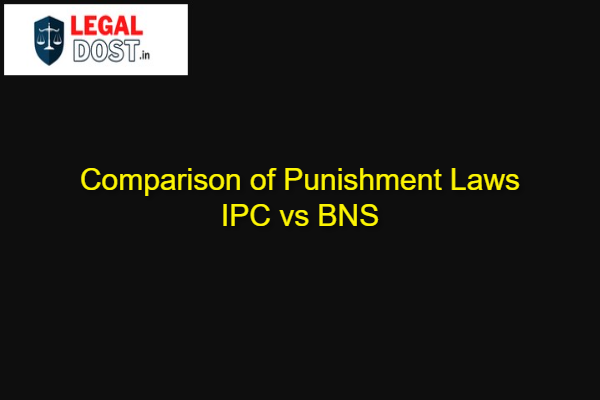Comparison of Punishment Laws IPC vs BNS
Here are some of the key differences between the Indian Penal Code (IPC), 1860 and the Bharatiya Nyaya Sanhita (BNS), 2023
Understanding IPC vs BNS: A Simplified Breakdown
Let’s suppose you’re updating an ancient rulebook—one written in 1860, during British rule. That’s the Indian Penal Code (IPC). Now, in 2023, India has decided to replace that old rulebook with a new one, called the Bharatiya Nyaya Sanhita (BNS). Both laws talk about what is a crime and how a person should be punished if they break the law.
Let’s walk through the major differences:
1. Death Penalty
IPC: Keeps the death penalty for very serious crimes—like murder or waging war against the country.
BNS: Also keeps the death penalty but introduces something new: in some cases, instead of death, a judge might order the convict to do community service.
So now, even in serious cases, there’s a chance to do social work instead of going to jail—if the law allows it.
2. Life Imprisonment
Both IPC and BNS say that “life imprisonment” means jail for your whole life—not just a few years.
️ No change here, but BNS makes the meaning clearer and more consistent.
3. Community Service – A New Concept
IPC: No such idea existed.
BNS: For small crimes (like petty theft or creating a public nuisance), instead of jail, a person may be asked to help society—like cleaning public places or working for a cause.
This is a modern idea that believes in reforming people, not just punishing them.
4. Fine
IPC: Fines were not always clear or consistent.
BNS: Has a more organized system for fines—and sometimes connects them to community service.
This makes punishments more balanced and fair.
5. Sedition (Rajdroha)
IPC: Anyone who said or wrote anything against the government could be jailed under “sedition” laws.
BNS: The word “sedition” is removed. Instead, there’s a new term: “acts endangering the sovereignty, unity, and integrity of India”.
This change is meant to avoid misuse of old colonial laws while still protecting national security.
6. Repeat Offenders
IPC: Didn’t clearly punish repeat offenders more harshly.
BNS: If you commit the same crime again, the law can now give you a stricter punishment.
Bad behavior repeated = tougher punishment.
7. Organized Crime & Terrorism
IPC: No special rules; courts used other laws like UAPA (Unlawful Activities Prevention Act).
BNS: Has new, dedicated sections for both organized crime and terrorism with very strong penalties.
Now, such serious crimes are handled within the main criminal law itself.
8. Mob Lynching
IPC: No specific law for lynching. It was treated as general murder.
BNS: Clearly defines mob lynching and punishes it with death or life imprisonment + fine.
This shows the law now recognizes modern forms of violence by groups.
9. Sexual Offenses
IPC: Defined rape and gangrape with strict punishment.
BNS: Keeps those punishments, but adds a new offense: if someone tricks another person into sexual relations by lying or pretending (e.g., false promise of marriage), that’s also now a crime.
The law now protects victims from emotional and sexual fraud, not just physical assault.
10. Attempt to Suicide
IPC: It was a crime to try to take your own life (though rarely punished).
BNS: Decriminalizes this act—meaning, it is no longer a crime. Instead, such people are seen as needing mental health care.
This is a shift from punishment to compassion.
So the gist is:
BNS is more modern—it focuses not just on punishment, but on reform and clarity.
It introduces new crimes relevant to today’s world (like mob lynching, terrorism, cyber deceit).
It is less colonial in language and more Indian in spirit.
It gives more options to judges: from community service to life imprisonment, depending on the crime.
It removes or updates outdated and controversial laws (like sedition, or punishing suicide attempts).
Bibhu Mishra is a prolific writer who has published many books spanning various genres. He is a legal enthusiast and an avid researcher of cutting-edge technology, diving into fascinating realms to bring captivating narratives to life.



